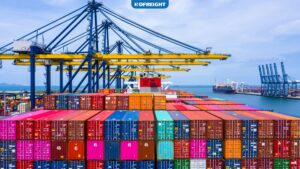The Last Mile Tracking system allows businesses to track their products and shipments from the point of origin to the final destination. This system gives companies real-time visibility into their supply chain, making informed decisions about their operations. This review will examine the technology behind tracking, benefits, and challenges in using the last mile tracking systems.
Table of Contents
What Is Last Mile Tracking?
In recent years, the logistics industry has been under pressure to improve the efficiency of the last-mile delivery process. The last mile is the most expensive and time-consuming part of the delivery process and often the most logistically challenging. Delivering goods to customers’ doorsteps is a complex operation that requires coordination between multiple parties, including retailers, manufacturers, 3PLs, and carriers.
Several factors have contributed to the increased pressure on the logistics industry to improve last-mile delivery. The growth of e-commerce has led to a dramatic increase in the number of packages that need to be delivered to customers’ homes. In addition, customers’ expectations for fast and free shipping have also increased. To meet these expectations, logistics companies have had to find ways to improve the efficiency of their last-mile delivery operations.
Logistics companies have attempted to improve last-mile delivery by using technology to automate the process. This includes using GPS to track vehicles and route optimization software to plan the most efficient delivery routes. In addition, many logistics companies are now using drones and robots to make last-mile deliveries. These technologies can help improve the delivery process’s efficiency and reduce costs.
In business, logistics is the management of the flow of resources between the point of origin and the point of destination to meet the requirements of customers or corporations. The resources managed in logistics can include physical items such as food, materials, animals, equipment, and liquids, as well as abstract items, such as time and information. Logistics is a complex and dynamic process involving coordinating many different activities. These activities can be divided into three main categories:
- Transportation: Transportation is moving goods from one location to another. This can be done by land, sea, or air.
- Inventory Management: Inventory management is tracking and managing the stock level in a warehouse. This includes activities such as order picking, packing, and shipping.
- Warehouse Management: Warehouse management is organizing and controlling the storage of goods in a warehouse. This includes activities such as receiving, storing and retrieving goods.
Logistics aims to ensure that the suitable goods are in the right place at the right time. This requires a careful balance of transportation, inventory, and warehouse management.
In the logistics industry, the term “last mile” refers to the final leg of a product or shipment’s journey to reach its destination. This final leg can often be the most complex and expensive part of the journey, as it typically involves multiple stops and can be subject to traffic delays.
Many logistics companies are turning to last-mile carrier tracking solutions to mitigate these challenges. These solutions use GPS tracking to provide real-time visibility into a shipment’s location and estimated arrival time. This visibility can help logistics companies optimize route planning, better manage customer expectations, and even provide proof of delivery.
While last mile carrier tracking solutions are not a silver bullet for all the challenges associated with the last mile, they can be a valuable tool for logistics companies looking to improve their operations. Last mile tracking is a critical part of the logistics industry, as it helps ensure that goods are delivered to customers promptly and efficiently. This process also helps improve customer satisfaction levels, as it allows customers to track the status of their orders and receive updates on their shipments’ progress.
Technologies Behind Last Mile Tracking
Technology has always played a pivotal role in the transportation and logistics industry. From the invention of the wheel to the development of the first automobiles, technological advances have helped to improve efficiency and safety in the movement of goods and people. In recent years, the transportation and logistics industry has undergone a digital transformation, with new technologies emerging that are changing the way carriers and shippers operate.
Last mile tracking is one of the most critical technologies for the transportation and logistics industry. This technology enables carriers to track their vehicles in real-time, allowing them to provide up-to-date information to their customers about the status of their shipments. The last mile carrier tracking also allows carriers to optimize their routes, which can lead to significant cost savings.
Many different technologies can be used in last mile tracking, each with advantages and disadvantages. Some of them include:
GPS Tracking
GPS tracking is the most popular method of last mile tracking. It is accurate, relatively inexpensive, and easy to use. GPS tracking has become an essential tool for businesses to keep track of their deliveries and ensure that their products are delivered on time and to the correct location. Using GPS tracking in last mile tracking, businesses can monitor their driver’s progress in real-time, identify potential delays, and re-route their drivers if necessary. This helps ensure that deliveries are made on time and to the correct address, saving businesses both time and money.
GPS tracking can also help businesses to improve their customer service. By tracking their drivers’ progress, companies can provide their customers with up-to-date information on their delivery status. This can help alleviate any anxiety or frustration customers may feel about their delivery status. Additionally, businesses can use GPS tracking to provide their customers with alternative delivery times or locations if there are any delays. The main disadvantage of GPS tracking is that things like tall buildings or trees can disrupt it. Another downside is that it requires a data connection, which can be expensive in some areas.
GPS tracking is a valuable tool for businesses that want to improve their Last Mile Tracking. Using GPS tracking, companies can monitor their driver’s progress, ensure that their products are delivered on time and to the correct location, and improve customer service.
RFID Tracking
RFID tracking is a newer technology that is becoming more popular for last mile tracking. It uses radio waves to communicate with tags that are placed on objects. RFID in last mile tracking has revolutionized the package delivery process for many companies. By tracking packages from the time they are loaded onto a truck until they are delivered to the customer, companies can ensure that packages are delivered on time and are not lost or stolen. This has led to a significant decrease in delivery times and an increase in customer satisfaction.
There are many benefits of using RFID in last mile tracking. First, it allows companies to track their packages in real-time, which means they can always see where their packages are. This will enable them to make changes to the delivery route if necessary, and it also allows them to track down lost or stolen packages. Additionally, RFID can help companies to identify which packages are being delivered to which customers, which can be helpful in the event of a delivery issue.
Overall, using RFID in last mile tracking has been incredibly beneficial for companies and customers. It has allowed companies to improve delivery times and track packages more effectively. It has also given customers peace of mind knowing that their packages are being followed.
Barcodes
Barcodes track packages from when they are shipped until they are delivered. This allows companies to know where their packages are and ensure they are delivered on time. Barcodes are read by scanners placed at various points along the shipping route. The scanner reads the barcode and sends the information to a central database. This allows the company to track the package’s progress and ensure that it is delivered to the correct address. Barcodes are typically used for tracking products that are being shipped by ground.
There are many benefits to using barcodes in last mile tracking. Barcodes are a quick and easy way to track packages. They are also very accurate and can be read by scanners at various locations. This makes it easy for companies to track their packages and ensure they are delivered on time.
Other Technologies
Other technologies can be used for last mile tracking, but they are not as common. Bluetooth tracking is one option, but it has a concise range and is not very accurate. NFC is another option, but it is not widely used.
While the technology for last mile tracking has come a long way, there is still room for improvement. The biggest challenge is accuracy, as GPS signals can be blocked or interrupted in urban areas. Another challenge is real-time tracking, as GPS data is typically only updated every few minutes. However, new technologies are being developed all the time, and the future of last mile tracking looks promising.
The Challenges of Last Mile Tracking in Delivery
This last mile is often the most expensive and logistically challenging part of the entire process. Many factors can impact the successful delivery of a product to a customer, including traffic, weather, and the customer’s location. The last mile tracking process is designed to track and manage these factors to ensure that the product is delivered successfully.
The challenges of last mile tracking can be divided into two main categories: logistical challenges and customer service challenges. The logistical challenges include ensuring that the product is delivered to the customer on time and in the condition that it was sent in. The customer service challenges include ensuring that the customer is satisfied with the product and that they receive the product on time.
The logistical challenges of last mile tracking are often the most difficult to overcome. This is because several factors can impact a product’s delivery, including traffic, weather, and the customer’s location. Last mile tracking systems must be flexible and adaptable to overcome these challenges. They must also be able to track and manage many different variables.
The customer service challenges of last mile tracking are often easier to overcome. This is because the customer’s satisfaction is the ultimate goal of the last mile tracking process. To ensure that the customer is satisfied, last mile tracking systems must be designed to be user-friendly and easy to use. They must also be able to provide the customer with the information that they need promptly.
Last mile tracking is a complex process but an essential part of the distribution process. By understanding the challenges of last mile tracking, companies can design better systems to meet their customers’ needs.
Advantages of Using Last Mile Tracking
There are several advantages to using last mile tracking for businesses, and these are as follows:
- Increased Efficiency: One of the main advantages of using last mile tracking is that it can help improve your business’s overall efficiency. This is because you will be able to track the progress of your deliveries in real-time, meaning that you can make any necessary adjustments along the way. This can help to save both time and money in the long run.
- Improved Customer Service: Another benefit of using last mile tracking is that it can help to improve your customer service. This is because your customers will be able to track the progress of their delivery, meaning that they can be kept up-to-date with its whereabouts. This can help to build trust and loyalty between you and your customers.
- Reduced Costs: Another advantage of using last mile tracking is that it can help to lower your costs. This is because you can always see where your deliveries are, meaning that you can make any necessary adjustments to the route to avoid unnecessary expenses. This can help to save your business money in the long run.
- Increased Visibility: Another benefit of using last mile tracking is that it can help improve your business’s overall visibility. This is because you will be able to track the progress of your deliveries in real-time, meaning that you can identify any potential problems along the way. This can help to improve the efficiency of your business as a whole.
- Improved Planning: The final advantage of using last mile tracking is that it can help to improve your planning. This is because you can track the progress of your deliveries in real-time, meaning that you can plan your routes more effectively. This can help to save both time and money in the long run.
Overall, there are several advantages to using last mile tracking for businesses. These advantages include increased efficiency, improved customer service, reduced costs, increased visibility, and improved planning.
In Conclusion
The Last Mile Tracking system is essential to the modern delivery process. Providing real-time tracking information helps ensure that deliveries are made on time and to the correct location. This system also provides valuable data that can be used to improve delivery efficiency and customer satisfaction.
If you’re looking for a digital freight forwarder that can provide real-time tracking, DFreight is the perfect solution. We offer a range of services that can help you streamline your delivery process and improve customer satisfaction. Contact us today to learn more about how we can help you.
FAQs
How accurate is Last Mile Tracking?
Last Mile Tracking is highly accurate, with a margin of error of fewer than 2.5 meters.
What is the difference between Last Mile Tracking and GPS Tracking?
GPS tracking is a technology that uses satellite signals to track the location of assets. Last Mile Tracking is a similar technology that uses GPS tracking to monitor and track the location of purchases during the final stage of their delivery.
What are the benefits of Last Mile Tracking?
Last Mile Tracking provides businesses with real-time visibility into the location of their assets, which can help to optimize delivery operations and improve customer service. Additionally, Last Mile Tracking can help to improve safety by providing businesses with the ability to track and monitor their assets in case of theft or damage.














